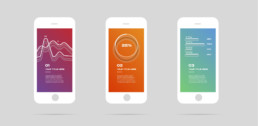
Portfolio Reviews @SF Design Week
Nine design hiring managers share their tips for creating a portfolio and what they’re thinking when they review one.
Melanie Araujo, Founder, Front & Center
Tanner Christensen, Head of Design, Gem
Marc Hemeon, Head of Creative and Digital, Kosas
Anna Iurchenko, Product Designer, Google Health (Moderator)
Abi Jones, UX Manager, Google Health
Cara Kleid, Principal UX Designer, Bill and Melinda Gates Foundation
Austin Knight, Product Designer, Google
Marissa Louie, Director of UX Design, Expedia
Pablo Stanley, Co-founder, Blush, Staff Designer, Lyft
Sean Wen, Product Design, Squarespace
Here are highlights from a wide-ranging conversation:
Q: What are you looking for when you review a portfolio?
Cara: A consistent story. Are you the right person for this role. I want your help categorizing what kind of designer you are.
Melanie: I want you to tell a good story and persuade me.
Abi: For you to show me what your contribution was, not just pretty pictures; I need to know your perspective to know whether you would fit on my team.
Pablo: Your visual design work is what will pull me in to read more about you. Then once you pass that filter, I’ll focus on how you talk about problems, the people you work with; how you talk about the people you design for, and how you are able to empathize with them. I’m not going to read the book if it doesn’t have a good cover.
Marc: Your work should fit the role you’re going for. There is room for everybody. I just hired an email designer, ad designer, and ux designer. There are lots of specialties today. Just make sure your contact information is on your portfolio, so I can call you.
Marissa: What is your lens on solving problems in the world (what is your background)? Critical thinking is an interdisciplinary partnership you can have in any company. I’m looking for someone who has a highly developed capacity for critical thinking.
Austin: The container of the work is as important as the work. If you’re applying for a pure interaction design role I’d be less concerned with your visuals, and more with business goals and user goals and how that influenced your work. I like to see what a person is doing outside of work. If you’re a volunteer, I want to hear about your passion.
Some designers think they need motion or other tricks for their portfolio to stand out. Your creativity should show in your design work. Add a little personality, because that lets me get a sense of who you are and your passion. Keep the portfolio simple and straightforward. Then link to other things that might highlight other aspects of you.
Cara: “Your creative brand”—that phrase makes me queasy. I’m not hiring a brand. Who are you, and what value can you bring to my team? We’re trying to figure out what you know, how you do what you do, and where you could fit into our team.
Q: Any suggestions for new grads?
Tanner: I always say if you don’t have experience, your number one job is to do some work (student, freelance, etc.). You can always find side projects to present your capabilities. Find problems in the world, and try to solve them. Build a case study of your design thinking and work.
Tons of small businesses have been devastated, so volunteer to help them and get some real-world experience. Approach it from a very humble perspective. Sometimes the best experience might be volunteering, because you can choose your projects based on what you want to learn and what you are able to do.
Marissa: If you’re not feeling great about one of your skills, look for work that will strengthen that area. Every designer is different and each case unique. Don’t take it personally if you’re rejected. Keep learning, moving forward, be true to yourself, and try to close gaps. Before you give up on design, seek a mentor who might guide you through.
Melanie: Design is a craft you practice and get better and better. You’re investing in yourself and building your skills with each project. Soft skills are also important. You can make a great design, but if you don’t know how to talk about it and sell it, then it is as if you never did it. You need to back it up with science and data to justify your work. You have to be a bit of a hustler at the beginning of a career.
Austin: Set up your portfolio so that if a hiring manager spends just 1-3 minutes, they will find what you want to show. On just the home page and first case study, get your main points across. Also make sure that the work you show reflects the role you want: mobile, visual, research, etc. Research is the core UX competency, supported by design or engineering. Show design artifacts, original photos of the process, lessons learned. Don’t be reluctant to show things that went wrong.
As a general rule, larger companies have more specialized design roles on larger teams, and smaller companies require more general design skills. The breadth of roles often correlates with the size of the company.
Austin publishes a website on UX design at uxdesignguide.com.